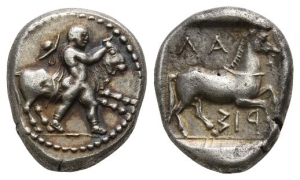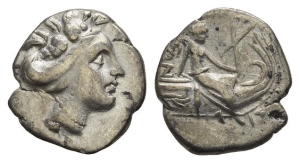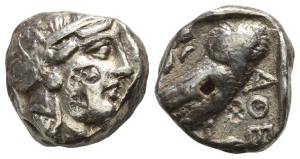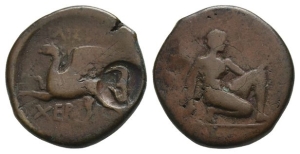Home > Auctions > 3 - 11 June 2025
Ancient Art, Antiquities, Books, Natural History & Coins
Near Extremely Fine. Toned with blue iridescence around the devices on obverse.
Acquired from Kevin Cheek (Elizabeth A. Cheek Trust Collection) in May 2011. Published in 'The Celator' December 1988.
From the article 'Artistic choice. Archaic style lived on Larissa' of Kevin R. Cheek about this coin in The Celator, December 1988, p. XXIIII: This remarkable issue is a combination of ''Archaic Period'' art and composition blended with ''Classical Period'' detail and design. The ''Archaic Period'' artistic style, readily seen on the obverse, is highlighted by the heavy body muscles of the bull wrestler seemingly flexing towards the viewer of the piece. The ''Archaic Period'' composition is noted with the heavy dot border, thick chunky flan, and deep reverse incuse. ''Classical Period'' detail and design is apparent relative to the delicate designed sandals, detailed neck-ribbing of the robust bull, and long-necked body of the horse. The artist has thus created a piece in which the bull wrestler commands sheer power over a stout adversary as the movement of the encounter gently displaces the petasus from the wrestler. The petasus may be significant in that there are many examples of as petasus being associated with the regal coinage of Macedonia.
Very Fine.
Ex German art market, 2000s. Acquired from an EU collector living in London. From the collection of a Surrey, UK, gentleman.
Near Very Fine.
Acquired in the mid 1980s-1990s. Private collection, Switzerland, thence by descent. Private collection, since the late 1990s.
Near Extremely Fine.
From the collection of a London antiquarian, formed since the 1980s.
Near Very Fine. Bankers' marks on both sides.
Private collection, acquired 1980–1985.
Near Very Fine. Rare with countermark.
Property of a North London, UK, gentleman.
Good Very Fine. Highlights of green patina.
Acquired Munich, Germany, in the early 1990s. From a private German collection. Property of a Kent, UK, lady collector since 2015.
The method of casting this unique type of coin was adopted by the Gallic Celts who originally came from this region. Dolphins were generally struck in the form of a tree attached to the tail, although some examples appear to have been cast individually.
Good Very Fine.
Acquired Munich, Germany, in the early 1990s. From a private German collection. Property of a Kent, UK, lady collector since 2015.
The method of casting this unique type of coin was adopted by the Gallic Celts who originally came from this region. Dolphins were generally struck in the form of a tree attached to the tail, although some examples appear to have been cast individually.
Good Very Fine.
Acquired Munich, Germany, in the early 1990s. From a private German collection. Property of a Kent, UK, lady collector since 2015.
The method of casting this unique type of coin was adopted by the Gallic Celts who originally came from this region. Dolphins were generally struck in the form of a tree attached to the tail, although some examples appear to have been cast individually.
Very Fine.
Acquired Munich, Germany, in the early 1990s. From a private German collection. Property of a Kent, UK, lady collector since 2015.
The method of casting this unique type of coin was adopted by the Gallic Celts who originally came from this region. Dolphins were generally struck in the form of a tree attached to the tail, although some examples appear to have been cast individually.
Very Fine.
Acquired Munich, Germany, in the early 1990s. From a private German collection. Property of a Kent, UK, lady collector since 2015.
The method of casting this unique type of coin was adopted by the Gallic Celts who originally came from this region. Dolphins were generally struck in the form of a tree attached to the tail, although some examples appear to have been cast individually.
Good Fine.
Acquired Munich, Germany, in the early 1990s. From a private German collection. Property of a Kent, UK, lady collector since 2015.
The method of casting this unique type of coin was adopted by the Gallic Celts who originally came from this region. Dolphins were generally struck in the form of a tree attached to the tail, although some examples appear to have been cast individually.
2089 - 2100 of 3130 LOTS
















